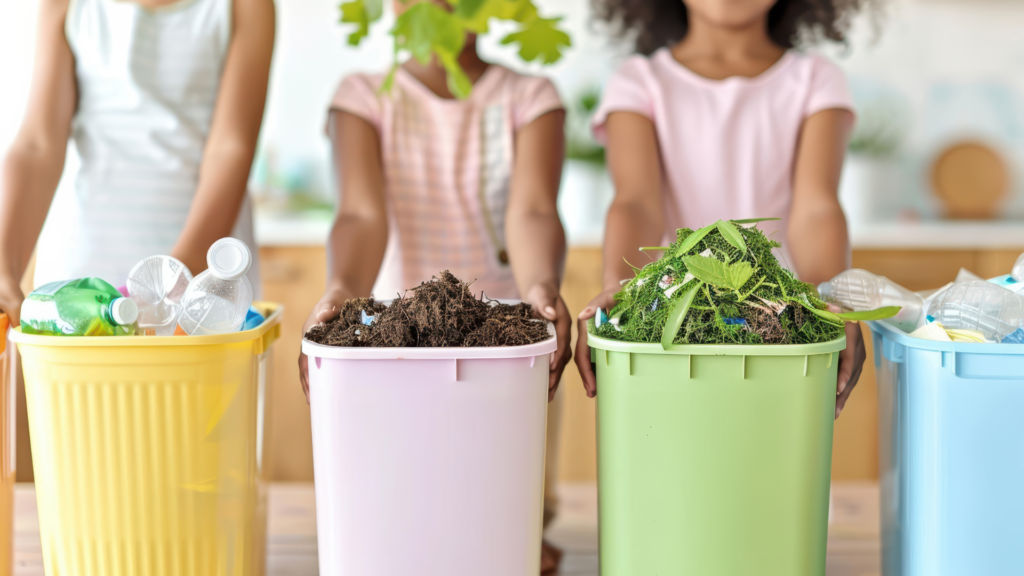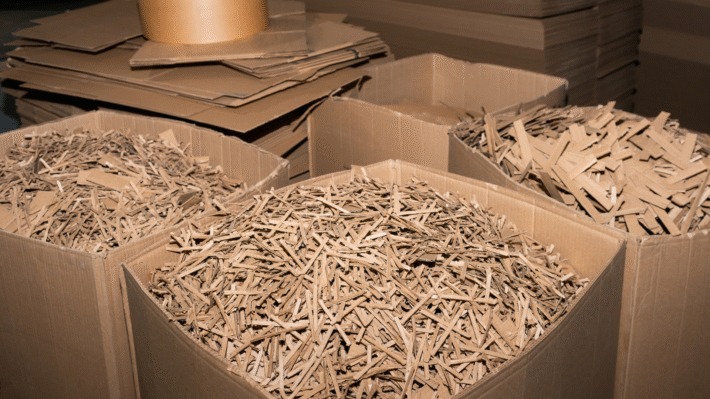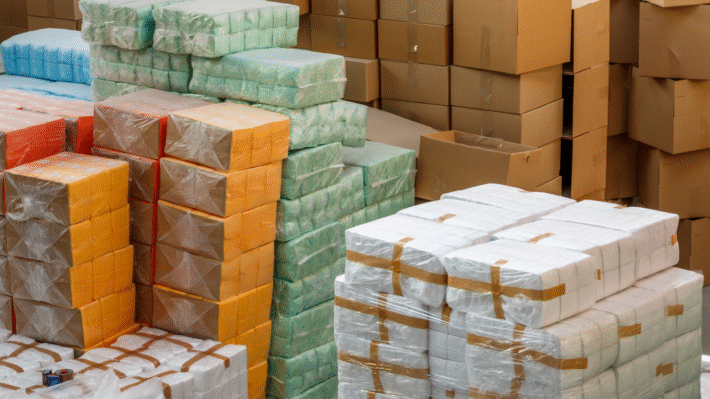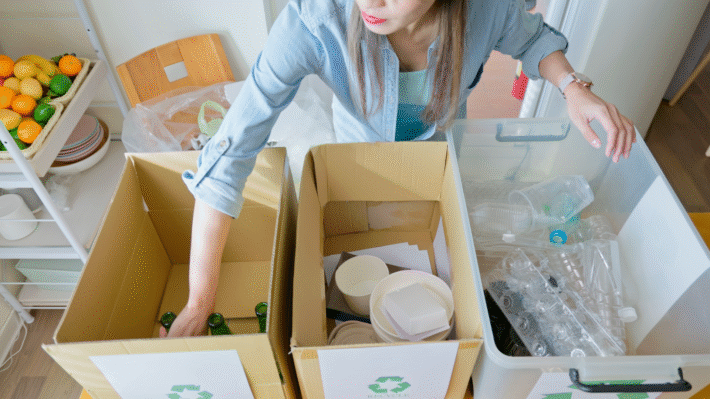Mastering Waste Prevention: Keys to Pollution Reduction, Source Reduction and Minimizing Byproducts

Welcome to the grand journey of Waste Prevention! Visionaries recognize that our world’s future depends on proactive pollution reduction, source reduction, and minimizing byproducts. This is not just our chance, but our obligation, to make a real difference. We’re not just altering, we’re revolutionizing the way we interact with the planet. Evolving from our classic “take, make, dispose” routine to a circular economy, considering every product’s life cycle, and manifesting a prevention-first culture in complete harmony with the environment. We’re looking at the bold new world of waste prevention, right from its Genesis of Zero to the future trends and challenges. This is a new, practical, positive frontier to explore. Let’s share that joy together in this exploration, getting hands-on knowledge about bio-integrated design, cleaner production, and KPIs. Are you ready to become part of the solution? Let’s dive in!
Genesis of Zero
In our pursuit to protect our little blue planet, it’s imperative we move from reactive to proactive. From putting out wildfires of pollution to preventing the sparks in the first place, our first step into this new paradigm is Moving Beyond Reactive Solutions. We need to forecast possible waste generation and take steps to nip it in the bud. By anticipating where waste will be produced, we can preemptively set up systems and processes to reduce or eliminate it.
The next critical element in our zero-waste saga is Understanding the Circular Economy. Imagine if, instead of buying a new phone every couple of years because your old one broke, you could simply have it repaired? Or better yet, what if it didn’t break in the first place? This is the goal of the circular economy: a system that’s restorative by design, where products and materials are continually cycled back through the economy instead of being thrown away.^[1]^ By framing waste as a design flaw rather than an inevitable output, we pave the way for massive reductions in pollution.
Embracing Life Cycle Thinking follows naturally from the circular economy. Next time you hold an everyday product, try to imagine how that item came to be in your hand. Where did the raw materials come from? What processes and resources were needed for its production? By expanding our perspective to encompass the whole story of a product, from material extraction to disposal, we can more effectively identify opportunities to cut down waste and reduce negative impacts.
The Precautionary Principle is another essential tenant of waste prevention. This principle holds that when there’s a chance that a process or product could cause severe or irreversible damage to the environment, precautionary measures should be applied, even if some cause-and-effect relationships aren’t fully understood yet.^[2]^ In practice, this means we should lean towards options that carry the least risk of causing harm, promoting innovations that work harmoniously with the environment and making proactive changes to established processes with potential harms.
Finally, fostering a Prevention-First Culture is central to our journey to zero-waste. Education, incentives, and mindful consumption are key. We all need to understand the importance of waste prevention and, more importantly, how to achieve it in our daily lives. Together, these elements form the foundational pillars for our journey towards achieving zero waste. However, the journey doesn’t end here. We must relentlessly seek to reduce sources of waste, minimize byproducts, and continually evaluate our progress, spending every ounce of our innovative vitality on an unyielding drive towards a sustainable, waste-free future.
[1]: The Ellen MacArthur Foundation offers a great introduction to the concept of the circular economy. (https://www.ellenmacarthurfoundation.org/) [2]: The Science and Technology Committee of the UK Parliament provides an in-depth explanation of the precautionary principle: (https://publications.parliament.uk/pa/cm201719/cmselect/cmsctech/328/32808.htm#_idTextAnchor015)
Source Reduction
Imagine a world with less waste. Sounds impossible, right? But here’s the thing: it’s completely achievable! All we need is to buckle down on our strategies for source reduction. This primarily relies on three key areas: innovative product design, lean manufacturing techniques, and encouraging lifestyle changes.
Innovative Product Design
Let’s start talking about product design. You see, most products today are designed to be used once and then thrown away. But what if we shifted that mindset? Our priority should be designing durable, modular products that can be repaired instead of discarded. You ever hear about digital products, right? These don’t need physical resources, meaning there’s no waste! So, let’s go digital wherever we can. Let’s design products made to last and stay relevant! (For more information, check this great article about durable product design)
Lean Manufacturing Techniques
Moving to the shop floor, let’s consider manufacturing. Manufacturing has always been the quintessential image of waste. Boxfuls of “factory rejects” anyone? But lean manufacturing is a game changer. It focuses on optimizing resources and minimizing waste (Yes! Exactly what we need!). We need more companies to opt for closed-loop systems that turn waste back into raw materials. Green chemistry and artificial intelligence (AI) tracking help make manufacturing processes more resourceful and less wasteful. (Interested in lean manufacturing? Here’s an awesome guide!)
Encouraging Lifestyle Changes
And then, there’s us. We can play a significant role in source reduction. By embracing concepts like the sharing economy, we can reduce the number of items we need to buy (and later discard). Food waste prevention comes down to smarter shopping and eating habits. Do-it-yourself (DIY) and digital minimalism can also help us cut down the waste our lifestyles generate. Remember, every single thing we DO NOT throw away is a victory for waste prevention! (Here’s a list of simple lifestyle changes to kickstart your journey towards less waste).
So, folks, the power to reduce waste is in our hands – in the products we design, in the ways we manufacture, and in the lifestyles we lead. Let’s get going!
Minimizing Byproducts
Minimizing Byproducts is not about an immediate transition, it’s a journey into a sustainable future. Now, let’s dive right in.
Industrial Symbiosis
First off, let’s talk about what I like to call, the “circle of life” of industrial processes, also known as Industrial Symbiosis. This is where every material’s use is maximized, and waste is minimized. There’s a fascinating case study of a town in Denmark called Kalundborg that exemplifies this, where a network of businesses use each other’s byproducts, saving heaps of money and reducing environmental impact (1). That’s cool stuff, isn’t it? Imagine a world where what’s waste for one, is a raw material for another!
Advanced Processing Technologies
Next up, we got Advanced Processing Technologies. These are the big guns that tackle waste head-on. Technologies like biorefineries, where our everyday waste is transformed into energy and more, or gasification, which turns stuff like agricultural residues into gas fuel, are changing the game (2). Even e-waste, the byproduct of our digital world, is getting a makeover with cutting-edge e-waste recovery technologies. Progress? I’d say heck yeah!
Effective Policies and Regulations
And, let’s not forget Effective Policies and Regulations. Governments around the world are setting extended producer responsibility (EPR) policies and targets, ensuring manufacturers are responsible for the waste they generate (3). Financial incentives are like honey, sweetening the deal for businesses to reduce byproducts and standardized tracking makes sure everyone’s playing the same game.
Tackling waste and minimizing byproducts is a systemic issue, needing collaboration from all sectors. With the right mindset and technology, we’re ready to step into a future with less waste, a cleaner environment and a better tomorrow. Remember folks, it might be a wild ride, but it’s most definitely worth it!
Future Trends
Are you itching to know what’s coming around the bend in waste prevention? Buckle up, amigo. We’re diving into the future trends shaping our disposal habits and our world.
Smart Systems Implementation
First up, we’ve got Smart Systems. Now, I know what you’re thinking: “What the heck does AI have to do with trash?” It’s not as far fetched as it seems. AI and IoT monitoring are playing increasingly prominent roles in waste reduction. Picture this: sensors paired with waste bins to monitor fill levels in real time, scheduling collections only when needed – talk about efficiency! AI algorithms can also sort waste accurately, reducing human errors. Plus, blockchain tech is stepping up, offering traceability of waste from source to final disposal. Imagine a transparent track of your old smartphone from your hand to a recycling facility. Neat, huh? Companies like Waste Robotics and RecycleGo are working their AI magic to revolutionize waste management.
Exploring Bio-Integrated Design
On to the second trend – Bio-Integrated Design. This is where biology meets architecture and design. We’re talking about creating and using living materials (yes, you read that right) derived from waste sources. Urban mining offers new ways to extract rare minerals from city waste. Edible packaging made from food waste is not a sci-fi anymore. Brands like Loliware are pioneering the edible cutlery space with items made from byproducts. No waste, only good taste. Is there anything cooler than reducing waste while snacking on your takeaway box?
Adopting Decentralized Solutions
Last but certainly not least on our future trends rundown- Decentralized Solutions. There’s power in people, folks. Communities worldwide are rallying together to manage their own waste locally, rather than relying on large-scale, centralized solutions. We’re witnessing more open-source tech platforms, promoting global collaboration on waste prevention. Local composting initiatives, neighborhood sharing platforms, recyclables exchange programs – all these are examples of how decentralized waste management is gaining traction. Your neighborhood could be the next hot spot for pioneering waste reduction practices!
I hope your imagination is buzzing now, pal. Waste prevention is not just about garbage, it’s about innovation. It’s about rethinking our habits, our products, our systems. As we venture into the future, these trends will continue to shape the waste prevention landscape, transforming not just how we dispose, but how we live. Stay tuned!
Measurement & Evaluation
Ever heard the phrase, “What gets measured, gets managed?” Well, in the world of waste prevention, we’re taking this mantra to heart! So, let’s dive into the three crucial components of our measurement and evaluation situation: Key Performance Indicators (KPIs), Life Cycle Assessment (LCA), and Continuous Improvement Strategies.
Key Performance Indicators
First up, we’ve got our KPIs. Now, KPIs aren’t just for sales teams anymore. We’re using KPIs like waste per capita, material intensity, and byproduct reuse to accurately gauge our progress in preventing waste.
Here’s the deal: waste per capita measures the amount of waste each individual generates. By keeping tabs on material intensity, we can tell how much resources we’re using relative to economic output. Lastly, by tracking byproduct reuse, we’re not thinking of waste as, well, “waste.” Instead, we’re seeing if they could pull double duty as a resource elsewhere.
Astonishing, right? But we’re not finished yet!
Life Cycle Assessment
Next is the Life Cycle Assessment (LCA). To truly appreciate the impact of our waste prevention strategies, we must think about the whole picture. LCA comes into play taking into account the impact from raw material extraction to end-of-life disposal.
In a nutshell, LCA lets us quantify the environmental impact of a product or service throughout its entire life. This understanding helps us refine our strategies and aim for the golden goal: zero waste. And take note- who said environmental care can’t be strategic?
Continuous Improvement Strategies
Lastly, we’ve got Continuous Improvement Strategies. Reducing waste isn’t a one-and-done deal; it’s an ongoing commitment that requires constant attention.
What does this mean? It involves regular monitoring and feedback loops. We check in on our KPIs and LCAs continually, keeping our strategies flexible to adapt to any changes. This way, for every step towards improvement, we make sure we make it better.
And of course, we always celebrate our advances (can you say, “reduced waste party?”) while staying focused on improving even more.
By using these three key tools in conjunction, we’re able to not only manage waste prevention efforts, but critically evaluate them to ensure maximum efficacy. From KPIs to LCAs to continuous improvement, we’ve got our waste prevention strategy measured, evaluated, and managed, all in the name of a cleaner, healthier, zero waste world.
So join us in our journey towards sustainable waste management. After all, we only have one planet, and the responsibility of protecting it lies upon us. Together, let’s turn our “wastes” into worthy resources!
Proactive Pollution Reduction
“It’s easier to prevent bad habits than to break them.” This wisdom from Benjamin Franklin applies not just to our personal habits but also to our mass production processes! Proactive pollution reduction isn’t a far-fetched dream, but a reality we can all strive towards with eco-design principles, cleaner production methods, and optimizing processes. Buckle up, as we’re about to deep dive into these fascinating concepts!
Eco-Design Principles
First off, let’s talk about eco-design. It’s like having your cake and eating it too! With eco-design, we make things durable, reusable, and repairable, all while using eco-friendly materials. That’s a home run, right? Eco-design principles help us to remodel everything from the clothes we wear to the electronics we use, and more! A living example of eco-design principle in action is Fairphone, a smartphone built with conflict-free minerals and designed to be long-lasting and repairable.
Cleaner Production Methods
Next up, let’s zoom into the manufacturing process. Companies around the universe are opting for cleaner production methods. Clean fuels, improved processes, and by-product utilization are the secret sauce to cleaner production. Companies like Tesla, with their electric cars and reusable rockets, are demonstrating that cleaner production is not only possible but also profitable!
Optimizing Processes
Lastly, we must look at optimizing processes. By incorporating digital management and streamlining processes, we can reduce waste significantly. Remember, time saved is waste averted! For instance, companies like Toyota, with their Lean Manufacturing method, exemplify how process optimization results in efficient production and minimal waste.
By adopting these proactive measures in pollution reduction, we can have a planet-friendly and cost-efficient production process. The Earth is our home, let’s act like it! Now, get out there and reduce, reuse, recycle and rock on!
Policies & Frameworks
Let’s delve into the realm of rules and regimens that govern waste prevention. The landscape spreads across three principal domains, namely, International Guidelines, National Policies, and Corporate Initiatives. Each plays an integral role in shaping the manner in which societies and industries battle the waste potentially harming our environment.
International Guidelines
The common threads that bind earth’s inhabitants have always been the air we breathe, the water we drink, and the soil nurturing our food. Hence, the sanctions against waste and its prevention cannot be limited to a single country. From Sustainable Development Goals (SDGs) set forth by the United Nations to the Basel Convention on the control of hazardous wastes movement, and the EU Action Plan for the Circular Economy, each serves as a beacon guiding societies globally.
Did you know that the Basel Convention aims to reduce the dangerous cargo of waste, particularly from developed to less-developed countries? It’s revolutionizing the way we handle waste on a global scale!
National Policies
Shifting our lens to a more intimate scope, let’s converse about National Policies. Different nations enforce various policies chiseled to their unique contexts and needs. Policies like Extended Producer Responsibility (EPR) makes producers accountable for the environmental impacts of their products. The Polluter Pays Principle is enforced to ensure that the cost of managing waste is borne by those who produce it or consume goods leading to it. Finally, Stewardship Programs promote responsibility for the longevity of natural resources.
The key lies in the adage: “Think Globally, Act Locally”. Every nation has a significant part to play in the grand scheme of waste prevention.
Corporate Initiatives
It is essential to recognize that a significant source of waste comes from corporate sectors. In today’s business landscape, numerous corporates are going beyond regulatory compliances adopting ambitious goals. From initiating Zero-waste commitments to pledging carbon neutrality and greening their supply chains, they clearly understand the role they play in the waste story.
Take, for instance, the tech giant Google. It has committed to become carbon-free by 2022 while investing in a portfolio of more than 50 wind and solar projects around the globe!
In a nutshell, the law of the land and cutting-edge corporate movements to cut waste and pollution guides us towards a more sustainable future. Remember, waste prevention must be everyone’s business!
Benefits
Brace yourself, folks! Waste prevention doesn’t only help Mother Earth, but it also does marvels for our pockets and the keystone of our society. You might be wondering, how? Well, let’s dive right in and explore these hidden treasures!
Environmental Advantages
If you’re worried about the health of our planet (and we all should be!), waste prevention can be your shield and sword in the battle against pollution. By cutting back on waste, we’re reducing the amount of rubbish that ends up in our lovely forests, pristine fields, and deep-blue oceans. This means less damage to natural habitats, cleaner water, and purer air. Plus, source reduction also means using less energy and producing less greenhouse gases, taking us a step closer in our fight against global warming.
If you want to know more on how waste prevention helps the environment, check this link here. Environment benefits of waste prevention.
Economic Gains
Alright, let’s talk about the mighty dollar! Dive into the world of waste prevention, and you’ll find that it makes a lot of cents…pun intended! When businesses minimize waste, they’re not just preventing damage to the environment. They’re also saving money on manufacturing costs, waste management, and cleanup. It’s like getting a two-for-one deal! Keeping resources in use for as long as possible means getting the max out of what we’ve got. That’s some solid cost-saving strategy!
Curious about the economic benefits of waste prevention? Here’s a nifty little resource to get you started. Economic benefits of waste prevention.
Social Improvements
Now, let’s not forget about the humans in all this. Waste prevention makes life better for us too! When businesses go green, they’re creating jobs in new industries like recycling and green-technology. Disposable culture? No, thank you! We’re talking about the rise of green jobs that help families and build stronger communities.
Plus, cleaner production methods mean fewer health hazards for workers and folks living close to manufacturing plants. Cleaner air, soil, and water make for healthier people. See? Everyone wins!
Keen to learn about the social benefits of waste prevention? Click on this link. Social benefits of waste prevention.
And there my friends, light up the fireworks! You now see how waste prevention has a hat-trick of benefits: environmental, economic, and social. So let’s all get on board the waste prevention train! Choo, choo!
Challenges
Reducing pollution, minimizing byproducts and becoming champions of a more sustainable planet can present a series of challenges. Navigating through these hurdles needs patience, persistence, and innovative thinking. Here, we delve into these issues a bit more.
Economic Hurdles
There is no denying the financial burden that comes with implementing waste prevention strategies. We live in a world geared towards fast consumption and disposal. High initial costs for implementing eco-friendly practices could deter businesses and individuals from making the necessary changes.
The buy-in in terms of training and equipment, such as compost bins or recycling facilities, can be significant. And this doesn’t even factor in potential lost revenue from switching to sustainable practices that may not immediately offer the same economic returns as the status quo.
Moreover, the lack of incentives can be another economic hurdle. From tax incentives to rebates, government bodies and institutions must pave the way and incentivize green behavior.
Institutional Barriers
Navigating the maze of regulations and guidelines can be daunting. Many of these policies are inconsistent, having been developed piecemeal over decades, with little thought given to how they fit into a broader picture of sustainable waste management.
Moreover, there is the issue of enforcement. Inadequate enforcement of existing regulations can send the wrong message, that it’s ok to continue with business as usual. Without a strong and centralized body to oversee these efforts, we could see a slow decline in progress towards waste prevention targets.
Behavioral Issues
Tackling behavioral issues may be the hardest puzzle piece to fit. We are a part of a throwaway culture where many of us prioritize convenience over sustainability. This mindset presents one of the biggest challenges to waste prevention efforts.
Education and awareness are pivotal in changing this mindset. Furthermore, we need to start having conversations about our waste habits, incentivizing cleanup initiatives, and supporting businesses that prioritize waste prevention and recycling. All this can help to build a new norm and culture around sustainability.
In the end, overcoming these challenges demands a collective effort from us all, from policy-makers and businesses to individuals. Facing these challenges head-on is the only way to forge ahead down the pollution-free path.
Staying on this journey can be tough, but remember, every step taken towards waste prevention is a step towards a greener, cleaner, and more sustainable future.
Sectors
Let’s travel together down a unique road – one lined with greener fields, towering eco-buildings, and bustling green kitchens. Welcome to the sectors showing how waste prevention can be achieved proactively, paving the way for a sustainably prosperous future.
Agricultural Practices
If you’re still wedded to the image of agriculture as endless, synthetic-chemical ridden fields, it’s time for an update![^1^] Smart agricultural practices are reshaping the sector, placing crop rotation at the fore. But why, you may ask? This cyclic routine tricks pests, disrupts disease cycles, and improves soil health, reducing the need for harmful pesticide use. Furthermore, the gripping shift towards organic farming and reduced-use of synthetic fertilizers assists in minimizing farmland pollution. Indeed, the future of farming is here, and it’s greener than ever![^2^]
Construction Innovations
Building dreams brick by brick – that’s construction! But guess what can make this dream greener? That’s right – embracing deconstruction and prioritizing the use of recycled materials! Constructive deconstruction, though paradoxical, ensures material recovery and waste reduction at source[^3^]. Moreover, rescued materials from demolished buildings, when reused, cut down the need for fresh resources. And the best part? It reduces the burden on landfills too![^4^] Now that’s innovation mixed with practicality!
Food Service Strategies
In the world of food service, waste is a word we can do without[^5^]. How? By adopting ingenious strategies like upcycled food utilization and recovery programs. For instance, left-over bread transformed into beer, yes, beer! And you thought waste was wasted, didn’t you? That’s the power of upcycling – breathing new life into food that would otherwise be discarded[^6^]. Additionally, food waste recovery programs can redirect surplus food from businesses to charity, contributing to a societal good[^7^].
In conclusion, proactive waste prevention is not merely a buzzword but a practical solution, seamlessly blending into different sectors. It’s high time we all lace our efforts into these sustainable patterns, shaping a better world for generations to come.
This piece is part of a bigger picture. Stick to this space as we continue unfolding the exciting realm of proactive pollution reduction, source reduction, and minimizing byproducts!
[^1^]: Link 1 [^2^]: Link 2 [^3^]: Link 3 [^4^]: Link 4 [^5^]: Link 5 [^6^]: Link 6 [^7^]: Link 7



